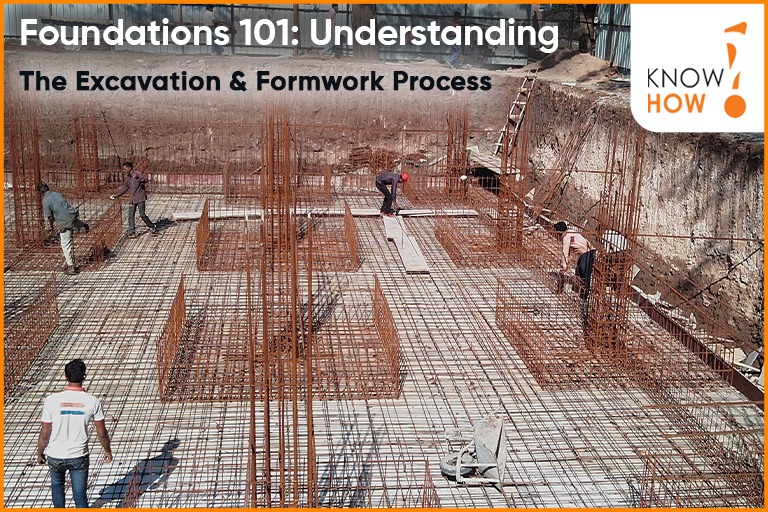Building a solid foundation is essential for any construction project. The foundation provides stability and support to the structure above, ensuring its longevity and safety. The process of creating a foundation involves excavation and formwork, which are critical steps in the construction journey. In this guide, we will delve into the excavation and formwork process, explaining their significance and the steps involved. By understanding these foundational elements, you can ensure a strong and durable base for your construction projects.
1. The Importance of a Strong Foundation
A strong foundation is vital for the structural integrity and longevity of any building. It transfers the load of the structure to the underlying soil or rock, providing stability and preventing settlement or structural failures. A well-executed foundation ensures the safety of occupants and protects against natural forces such as earthquakes or soil movements.
2. Excavation Process
Excavation is the process of removing soil, rock, or other materials from the construction site to create space for the foundation. It involves several essential steps to ensure a proper and well-prepared excavation site.
2.1 Site Preparation
Before excavation, the site needs to be prepared by removing any obstructions, vegetation, or debris. Clearing the site ensures safe and unobstructed access for excavation equipment.
2.2 Marking and Layout
Marking and layout involve identifying the dimensions and boundaries of the foundation on the ground. This step ensures accurate excavation according to the building plans and specifications.
2.3 Excavation Techniques
Excavation techniques vary depending on the soil conditions, project requirements, and depth of the foundation. Common excavation methods include open excavation using machinery like excavators or backhoes, and deep excavations using retaining systems like soldier piles or secant piles for added stability.
2.4 Safety Considerations
Safety is paramount during the excavation process. Adequate shoring or bracing systems should be implemented to prevent collapses or soil movements. Regular inspections, proper training, and adherence to safety regulations are crucial for maintaining a safe work environment.
3. Formwork Process
Formwork is the temporary structure used to shape and support the poured concrete until it hardens and gains sufficient strength. It provides the desired shape and dimensions to the foundation and plays a critical role in achieving a structurally sound result.
3.1 Types of Formwork
Formwork can be constructed using various materials such as timber, steel, or engineered formwork systems. The choice of formwork depends on factors such as the complexity of the foundation, budget, and required number of reuses.
3.2 Formwork Installation
The installation of formwork involves assembling the form panels, reinforcing bars (rebar), and support systems to create the desired shape and dimensions. Careful attention must be given to ensure accurate alignment and proper bracing for stability.
3.3 Reinforcement and Concrete Pouring
Once the formwork is in place, reinforcing steel bars are installed to provide strength and reinforcement to the foundation. After the rebar is secured, concrete is poured into the formwork, ensuring complete coverage and proper compaction to eliminate air pockets.
3.4 Formwork Removal
Formwork removal should only be done when the concrete has gained sufficient strength to support its weight and any anticipated loads. The removal process requires caution to avoid damage to the newly poured foundation.
4. Common FAQs
FAQ 1: How long does the excavation and formwork process take?
The duration of the excavation and formwork process depends on the size and complexity of the foundation, soil conditions, and weather. Smaller residential foundations may take a few days, while larger commercial projects can extend over several weeks. Proper planning, coordination, and scheduling are crucial to streamline the process.
FAQ 2: Can formwork be reused?
Yes, formwork can be reused, especially when using engineered formwork systems or modular systems designed for multiple reuses. Proper care, cleaning, and storage after each use help maintain the formwork’s integrity and extend its lifespan.
FAQ 3: What are common challenges in the excavation and formwork process?
Common challenges include dealing with unexpected soil conditions, ensuring accurate alignment and dimensions, managing formwork stability during concrete pouring, and maintaining safety during the entire process. Proper planning, experienced professionals, and proactive problem-solving are essential to overcome these challenges.
Conclusion
Understanding the excavation and formwork process is essential for creating a strong foundation in construction projects. The excavation process involves site preparation, marking and layout, excavation techniques, and adherence to safety considerations. Formwork plays a crucial role in shaping the foundation, ensuring accurate dimensions, and providing support during concrete pouring. By following these steps and considering the common FAQs, you can lay the groundwork for a successful construction project with a solid and durable foundation.

